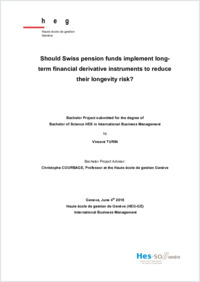Should Swiss pension funds implement long- term financial derivative instruments to reduce their longevity risk?
SONAR|HES-SO
- Turin, Vincent
- Courbage, Christophe (Degree supervisor)
-
2018
Mémoire de bachelor: Haute école de gestion de Genève, 2018
English
During the last decades, the Swiss population has been experiencing an increase in life expectancy. Switzerland has seen a change in the structure of its population. In 1900, the proportion of people aged below 20 years old was 40.7% of the total Swiss population, whereas in 2016, this percentage was of 20.1%. In contrast, the proportion of people aged over 60 years old has increased significantly from 5.8% to 18.1% of the total Swiss population. (Office Fédéral de la Statistique 2018) This shift towards a more ageing population is bringing new challenges to the society. This study looks at one of these challenges, the longevity risk for Swiss pension funds. The ageing-population phenomena has a significant impact on these organizations. Indeed, as people continue to live longer, the pension funds have to pay rents to beneficiaries during longer periods. Consequently, the commitments of these organizations are currently increasing and more of them face difficulties. This issue is exacerbated with the economic environment and the historically low returns of financial markets. In this context, the United-Kingdom has developed a market to transfer longevity risk via long-term financial derivative instruments. Investors have the possibility to diversify their portfolios by bearing a part of the pension funds’ longevity risk. The objective is to share longevity risk among more participants with this method pension funds have less risk to be in financial distress and beneficiaries have additional guarantees to receive their rents. The goal of this project is to find out if this solution is applicable to Switzerland. The results of this paper are based on analytical research and on interviews of professionals. The paper highlights the fact that longevity risk is not borne in the same way in Switzerland than in the UK. In Switzerland, private companies face less risk and have therefore less incentive to transfer the longevity risks of their pensions funds. The study also reveals the small size of the Swiss market for the development of these derivative instruments. Indeed, the providers of these instruments want to transfer significant quantities of longevity risk. For them a pension fund is interesting if it has at least 5 billion in its balance sheet (Appendix 5 Interview Mr. Maeder). However, in Switzerland, only 7.68% of the pension funds have more than 1 billion in their balance sheets (ASIP 2018). In addition to that these financial instruments are expensive and complex to use. These findings lead to questioning whether the conditions for the implementation of these financial instruments are met in Switzerland and if the providers of these instruments (investment banks, insurance and reinsurance companies) are willing to develop the Swiss market.
- Language
-
- English
- Classification
- Economics
- Notes
-
- Haute école de gestion Genève
- International Business Management
- hesso:hegge
- License
- License undefined
- Identifiers
-
- RERO DOC 323619
- Persistent URL
- https://folia.unifr.ch/global/documents/314726
Statistics
Document views: 111
File downloads:
- Vincent_Turin_Final_TB.pdf: 227
